Once you have confirmed what information is required, whether it is regarding a product, service or an individual animal, you need to:
- Locate sources that meet the information need
- Select the most reputable source
- Correctly interpret the relevant information.
Locate sources of relevant information
Using the resources available to you, locate sources of relevant information. You may use a variety of different sources for the same information need. For example, you may access workplace resources and product brochures, and find some sources from validated internet sites, all related to the same range of animal care products or services. For individual animal information, you will likely need to access workplace information management systems, industry databases and/or government registers.
Select the most current source of reputable information
As you learned from the previous topic, there are often multiple sources of similar information. Once you have found a reputable source, you then need to evaluate the source in terms of currency and coverage. In other words, ask yourself the following questions:
- “Currency:
- When was the information published?
- Is the information current or outdated?
- Does currency matter in this topic?
- Coverage:
- Does the information covered meet your information needs?
- Does it provide basic or in-depth coverage?” (Run Run Shaw Library 2022)
Once you have evaluated the sources, select the most appropriate source for your, the client’s or team member’s information needs. Products and services often change over time regarding availability, price, contents and many other factors. So, you should always use the most up-to-date source when providing information to others.
It is important to evaluate coverage in terms of the information needed. Choose a source that clearly provides the information that is required. It can be very frustrating for the other person if you give them irrelevant information and/or don’t answer their original question.
You should also evaluate coverage in terms of the level of detail. Use questioning and active listening to gauge the level of detail the other person requires, then select a source that meets that need. It can be frustrating for the other person to be bombarded with excess information they are not interested in or if they must keep asking questions to get the level of detail they want.
It is often easier to select a source with more detail than is required but only to provide the information that is needed. If the other person has follow-up questions, you can use the same source again rather than finding a new source with greater coverage.
Correctly interpret the information

Once you have accessed information about animal care products and services, it is important that you can interpret it – that is, you can read and understand the information. Interpreting information for animal care needs will involve you locating and understanding details within the source, such as:
- purpose of the product or service
- product ingredients or service contents
- instructions relating to product use or requirements pre-service
- safety precautions or considerations
- quantities and measurements
- application requirements.
Tips for effective interpretation of written information
Rather than reading an entire document, which can be time-consuming, you should use strategies to locate sections of the document in which you may find the information you require. Such strategies include:
- Reviewing the document’s contents to identify relevant sections
- Searching for words or phrases, using the glossary or a search function for electronic documents (for example, use Ctrl + F in Microsoft Word® or Adobe Acrobat® programs or on webpages)
- Referring to key parts of figures and diagrams, such as the legend (which tells you what the symbols or colours represent) and the scale, if appropriate
- Scanning the document – to quickly read and develop a broad understanding of the subject and the key information the document contains. When scanning a text, do not read every word or sentence. Rather, let your eyes fall over the text and search for the key information you need. You may use a finger to help guide your eyes logically and systematically through the text, searching for key information.
- Reading actively – that is to process the material as you progress through it by:
- Identifying key ideas in the document, using a highlighter or underlining
- Making notes on the document to help clarify your thoughts
- Using a dictionary to obtain the definitions of words you are unsure about
- Re-reading the document later, in whole or in part, as required.
If you have attempted to interpret a source of information about an animal care product or service and you are still unsure about what it means or how to apply it, it is vital that you seek advice from an appropriate person. An ‘appropriate person’ may include your work supervisor, a manager, an experienced colleague or an external expert on the topic.
Interpreting numerical information
Animal care product and service information often involve numbers. This numerical information can be extremely important for providing specific details to the client or team member. In the case of health care products, it may even be life-threatening if you misinterpret the numerical information, for example, leading to the incorrect dose of medication.
Quantity and measurement
A quantity is the amount or the number of something. In other words, the quantity is ‘how much’ or ‘how many’ of something. For example, a client may want to know how many (the quantity of) single-serve pouches are in the bulk package, the maximum number of snakes that can be kept together in a particular enclosure, or the number of supplements to give their guinea pig every day.
Measurement is the process of determining the quantity of something. To measure something, you require a specific tool for the type of measurement. For example, you may use a ruler or tape measure to determine the length or dimensions or something, a scale to measure weight or a measuring cup or jug to measure volume.
Quantities can also be measured in terms of specific qualities, such as length, weight and volume.
Length and dimensions
Length measures how long an object is – the distance between the start and end of something. For example, the length of a snake is the distance between the tip of its nose and the tip of its tail.
The dimensions of an object are the combined lengths of the different sides. For example, the dimensions of a birdhouse include the lengths of the width (from side to side), height (from top to bottom) and depth (from front to back).
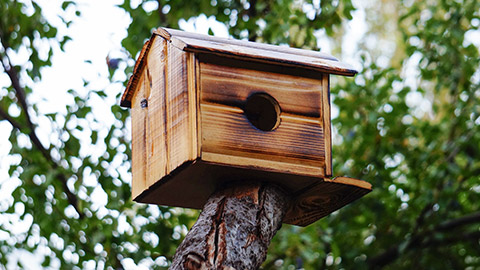
Length measurements may also relate to the size of objects, such as the length of a grooming brush or the chest measurement of a car harness.
Weight and volume
Weight is a measure of how heavy an object is. The base unit of weight is the kilogram (kg). However, depending on the object being weighed, you may use smaller units that are conversions of the kilogram.
| Unit | Microgram | Milligram | Gram | Kilogram |
|---|---|---|---|---|
| Symbol | µg | mg | g | kg |
| Conversions | $$\begin{aligned}&1\,\mu\mathsf{g}\;=\;\frac{1}{1000\;\mathsf{mg}}\\&1\,\mu\mathsf{g}\;=\;\frac{1}{1\,000\,000\;\mathsf{g}}\\&1\,\mu\mathsf{g}\;=\;\frac{1}{1\,000\,000\,000\;\mathsf{kg}}\end{aligned}$$ | $$\begin{aligned}&1\,\mathsf{mg}\;=\;1000\;\mu\mathsf{g}\\&1\, \mathsf{mg}\;=\;\frac{1}{1000\;\mathsf{g}}\\&1\, \mathsf{mg}\;=\;\frac{1}{1\,000\,000\;\mathsf{kg}}\end{aligned}$$ | $$\begin{aligned}&1\,\mathsf{g}\;=\;1\,000\,000\;\mu\mathsf{g}\\&1\, \mathsf{g}\;=\;1000\;\mathsf{mg}\\&1\, \mathsf{g}\;=\;\frac{1}{1000\;\mathsf{kg}}\end{aligned}$$ | $$\begin{aligned}&1\,\mathsf{kg}\;=\;1\,000\,000\,000\;\mu\mathsf{g}\\&1\, \mathsf{kg}\;=\;1\,000\,000\;\mathsf{mg}\\&1\, \mathsf{kg}\;=\;1000\;\mathsf{g}\end{aligned}$$ |
| Examples of when to use | For tiny amounts, such as the weight of the active ingredient in a medication. | For very small amounts, such as the weight of a specific vitamin in a supplement tablet. | For small amounts, such as the weight of wet food in a pouch. | For larger amounts, such as the weight of a dog. |
Volume is a measure of how much space a liquid takes up. The base unit of volume is the litre (L). However, as with weight, there are unit conversions to use for different quantities.
| Unit | Microlitre | Millilitre | Litre | Megalitre |
|---|---|---|---|---|
| Symbol | µL | mL | L | ML |
| Conversions | $$\begin{aligned}&1\,\mu\mathsf{L}\;=\;\frac{1}{1000\;\mathsf{mL}}\\&1\,\mu\mathsf{L}\;=\;\frac{1}{1\,000\,000\;\mathsf{L}}\\&1\,\mu\mathsf{L}\;=\;\frac{1}{1\,000\,000\,000\,000\;\mathsf{ML}}\end{aligned}$$ | $$\begin{aligned}&1\,\mathsf{mL}\;=\;1000\;\mu\mathsf{L}\\&1\,\mathsf{mL}\;=\;\frac{1}{1000\;\mathsf{L}}\\&1\,\mathsf{mL}\;=\;\frac{1}{1\,000\,000\,000\;\mathsf{ML}}\end{aligned}$$ | $$\begin{aligned}&1\,\mathsf{L}\;=\;1\,000\,000\;\mu\mathsf{L}\\&1\,\mathsf{L}\;=\;1000\;\mathsf{mL}\\&1\,\mathsf{L}\;=\;\frac{1}{1\,000\,000\;\mathsf{ML}}\end{aligned}$$ | $$\begin{aligned}&1\,\mathsf{ML}\;=\;1\,000\,000\,000\,000\;\mu\mathsf{L}\\&1\,\mathsf{ML}\;=\;1\,000\,000\,000\;\mathsf{mL}\\&1\,\mathsf{ML}\;=\;1\,000\,000\;\mathsf{L}\end{aligned}$$ |
| Example of when to use | For tiny volumes, such as the volume of the active ingredient in a liquid medication. | For small volumes, such as the volume of spot-on preparation in a flea topical. | For larger volumes, such as the volume of shampoo in a bulk container. | For very large volumes, such as the volume of water in an equine hydrotherapy pool. |
Ratios
A ratio is the quantity of one thing compared to the quantity of another thing. For example, the number of chickens allowed to be kept compared to the area they are kept in, the number of doggy day care animal attendants needed compared to the number of dogs, or the dimensions of an enclosure compared to the size of the animal.
There are three ways to express a ratio.
The first method is to add a colon between the two values. For example, the ratio of animal care attendants to dogs in a day care facility is 1:10. The order of the numbers must match the order of the items in the sentence. In this example, 1 animal care attendant is required for every 10 dogs.
The second method is to use the word ‘to’. For example, the ratio of animal attendants to dogs in a day care facility is 1 to 10. Again, the order of numbers must match the items in the sentence.
The last method of presenting a ratio is as a fraction. For example, the ratio of animal attendants to dogs in a day care facility is 1/10. With this method, the first item mentioned is always the numerator (top number) of the fraction, while the second item is the denominator (bottom number).
If you change the order of the items in the ratio, you must change the order of the numbers in the ratio. For example, if we change the order of the sentence to say ‘the ratio of dogs to animal care attendants’, then we need to change the order of the numbers in the expressed ratio – 10:1 or 10 to 1.
However, when expressing a ratio as a fraction, the lowest number is typically the numerator.
Cost
Cost is the amount of money that is required to pay for a product or service. When sourcing information about cost, you may need to look for terms such as price, fee or charge.
In Australia, the cost is expressed in Australian Dollars (AUD). However, it is typically written with a simple dollar symbol, $. For example, the cost of a training clicker could be $11.95.
When sourcing cost information online, ensure the website's currency is set to AUD. Many other countries, including the United States of America (USD), Singapore (SGD) and Canada (CAD), also use dollars. However, the price in AUD is not the same amount as in USD, SGD or CAD.
Decimals
Decimal numbers represent quantities based on whole numbers and parts of numbers. The number before the decimal point shows how many whole numbers and the first number after the decimal point shows how many tenths. A tenth is one whole divided into 10 equal parts. Therefore 0.5 is equal to a half, 0.5 = 1/2.
For example, a small dog weighing 5.4 kg is 5 whole kilograms plus 4 tenths of a kilogram. Further, this dog is 1 tenth of a kg less than 5.5 kg.
Review the following video (4:05 min), which is a refresher about place value, including decimal numbers.
Interpreting safety information
Safety information is always important. As part of your duty of care to the animal, you must do your best to provide information about risks and hazards associated with the products or services for which you source information – even if it is not necessarily part of the information requested.
Product safety information
While detailed product safety information is provided in safety data sheets (SDS), if a product poses a risk, warning and safety information is included in the full product brochure as well as written directly on the packaging. For example, parasite topical treatments for dogs may have warnings on the packaging such as, “CAUTION KEEP OUT OF REACH OF CHILDREN” or “FOR ANIMAL TREATMENT ONLY”. Safety directions may include information such as “Avoid contact with eyes”; “Wash hands after use”; “Do not swallow”; or “If poisoning occurs, contact a doctor or Poisons Information Centre”.
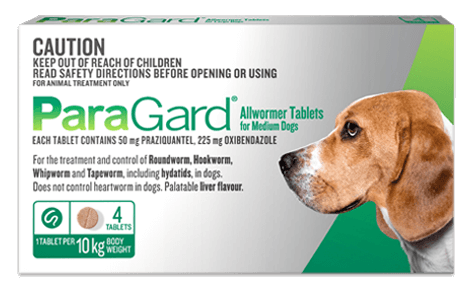
The following table outlines some common safety information associated with the different types of animal products.
| Product type | Associated safety information |
|---|---|
| Dietary needs |
|
| Animal housing items |
|
| Health and hygiene products |
|
| Enrichment items |
|
| Grooming products |
|
| Training products |
|
Service safety information
As with products, there are risks associated with animal care services. While the risks are usually low, it is important to provide the information to the client so they can make informed decisions about the services. The specific safety risks will depend on the specific nature of the service. Make sure to read the information about safety carefully before providing it to a client. If you cannot find any information regarding safety, you may need to make enquiries or source additional information to clarify or confirm safety concerns or precautions related to the service.
The following table outlines some common safety concerns associated with different types of animal care services. The examples are not exhaustive, nor guaranteed. Make sure to read the safety information specific to the service.
| Service category | Associated safety risks |
|---|---|
| Boarding and day care facilities |
Injury to client's animal as a result of:
Risk of client’s animal:
|
| Grooming services |
Risk of client’s animal:
|
| Training services |
Injury to client's animal as a result of:
Risk of client’s animal:
|
| Veterinary and allied health services |
Risk of client’s animal:
|
| Outsourced services | Risks will depend on the specific outsourced service |
Interpreting industry terminology
As with any industry, there are specific terms that relate to animal care. Recognising and understanding what these terms mean will help you interpret product and service information accurately.
The following table lists some safety, scientific and health care terminology that are commonly found in animal care product SDS and product or service brochures.
| Unit or term | Explanation or definition |
|---|---|
| Common safety terms | |
| Hazard (e.g., environmental hazard) | A source of potential harm, for example, to the environment |
| Precaution (e.g., personal precaution) | A measure taken to reduce the risk, for example, to yourself |
| Contaminate | Adding a dangerous, toxic or polluting substance to something |
| Flammable | Can catch fire |
| Ventilated | Free-flowing air |
| Sanitised | Cleaned with disinfectant |
| Common scientific terms | |
| mL/L | Millilitres per litre |
| kg | Kilograms |
| g | Grams |
| mg | Milligrams |
| Aquatic | Freshwater (lakes and rivers) |
| Marine | Saltwater (ocean) |
| Terrestrial | Ground-based |
| Arboreal | Lives in trees |
| Consumed | Eaten |
| Common heath care terms | |
| Indications | Reasons to apply the product |
| Contraindications | Reasons not to apply the product, for example, during pregnancy |
| Triannual | Three times per year |
| Annual | Once every year |
| Oral | Mouth |
| Ocular | Eyes |
| Dermal | Skin |
| Gastrointestinal | Digestive system |
| Ectoparasite | Parasites that live on the surface of the host, for example, ticks |
| Endoparasite | Parasites that live inside the host, for example, intestinal worms |
| Carcinogen | Something that can cause cancer |
Knowledge check 3

Recall that an animal care product is an item that can be purchased for and used in the care of an animal, such as food, health products or enrichment items.
Product manufacturers publish information about their products. As someone working in the animal care industry, it is your job to know how to research products for clients, interpret the information accurately, and then provide that information to the client in a way that they can easily understand. However, animal care product marketing can be confusing and even misleading. It is critical that you read all the product information, including any fine print, to make sure you provide accurate information.
Two product categories to be particularly careful with are dietary items and parasite preventatives.
In Australia, there is no regulatory body for pet food. This means that there is no legislation concerning the manufacture of pet food in any state or territory. Instead, it is regulated with voluntary industry standards applied through the Pet Food Industry Association of Australia (PFIAA). For further information on this subject, review the 'Australian Government response to the report of the Senate Rural and Regional Affairs and Transport Committee: Regulatory approaches to ensure the safety of pet food'.
For example, when a specific protein source is listed, such as beef or chicken, there are no requirements that the ingredient is actual meat. Instead, it could contain beaks, hooves, blood, skin, fat, blood or other animal components. There are also no requirements for the minimum quantity of the ‘meat’. The weights listed are also typically measured before dehydration, meaning the amount of meat content can be up to 80% less than what is listed.
Terms such as ‘balanced’, ‘premium’ or ‘holistic’ on dietary items are also not regulated and, therefore, should not impact decision-making around appropriate food items for a particular animal. Instead, focus your research on veterinary-recommended foods that are backed by scientific studies.
Parasite preventative information can also be confusing. Many products may have ‘all wormer’ or ‘complete parasite control’ on the box but may not cover all important parasites. For example, many ‘all wormers’ do not cover tapeworm.
Another thing to keep in mind is when looking at products that cover multiple parasites, make sure to check the application schedule carefully. The different active ingredients often have different durations for efficacy. For example, the product could be marketed as a monthly flea and tick preventative. However, it prevents fleas for one month but only prevents ticks for two weeks.
To ensure you provide accurate information, make sure you read the entire product brochure or insert, including any fine print, and double-check exactly what parasites are covered and for how long.
Types of animal care products

There is a massive variety of animal care products available across several categories. However, in this module, we shall focus on the following six categories:
- Basic dietary needs, including food products, supplements, and treats. For example, cans of wet dog food, chicken pellets, guinea pig vitamin C supplements, cat liver treats, etc.
- Animal housing items: For example, cat beds, dog kennels, fish tanks, reptile enclosures and rodent cages, etc.
- Health and hygiene products: For example, medications, parasite control, shampoos, kitty litter, disinfectants, etc.
- Enrichment items: For example, toys, cat towers, bird swings, items to encourage specific behaviours, such as foraging, grooming and social interaction, etc.
- Grooming products: For example, brushes, clippers, fur or feather treatments, etc.
- Training products: For example, leads, halters, collars, clickers, obstacles, etc.
Animal care product information
Animal care product information can be grouped into two broad classes:
- General information, including:
- purpose, including intended species and life stage
- ingredients, contents or materials used
- Use By or Best Before dates
- recommended retail price.
- Product instructions, including:
- measurements
- recommended quantities and frequencies of use
- instructions for assembly, use and disposal
- applications, including species, breed, weight, size or other limits
- associated safety precautions.
The following table provides some examples of the types of information you may be required to interpret about some common animal care products.
| Animal care product | General product information | Product instructions |
|---|---|---|
| Basic dietary needs |
|
|
| Animal housing items |
|
|
| Health and hygiene products |
|
|
| Enrichment items |
|
|
| Grooming products |
|
|
| Training products |
|
|
Select information according to the identified need
Once you have sourced animal care product information, you need to review it so you can select the information that is relevant to the identified need. Recall (and confirm if required) the client’s or team member’s information need. What do they need to know? Does the information you sourced contain those details?
- Product purpose – the intended use of the product. For example, the behaviours targeted by a particular enrichment item.
- Product contents – the materials or ingredients used to make the product. For example, the key ingredients in poultry feed.
- Product instructions relating to:
- Use –instructions for the appropriate method of applying or using the product. For example, the steps involved in constructing a cat gym.
- Safety precautions –instructions for the safe use of the product and warnings against improper use. For example, warnings against leaving the animal unsupervised with a new training product.
- Quantities – instructions for the amount of product to be used at any one time. For example, to use the entire pipette of liquid topic solution in a single application.
- Measurements – instructions related to weights, volumes or dimensions of the product. For example, the chest measurements for different sizes of car harnesses for dogs.
- Application requirements – instructions for the species, breed, size, weight or other limitations for using the product. For example, the size of a rodent cage may be suitable for up to eight mice but only up to two rats.
- Other product information – may include information about the origin of the product components or ingredients; product quality testing results; diagnostic information; troubleshooting tips; and much more. For example, many parasite control products provide descriptions of common symptoms of parasite infestations.
Interpreting product information
Once you have identified the relevant information, you then need to interpret it accurately so you can provide it to the client or team member effectively.
Product brochures, labels and leaflets
The product brochure, full label or leaflet typically contains all the information you will require about a product. Unlike SDS, there is no recommended structure for product labels and brochures. Therefore, it is important to read the entire document to ensure you can find and interpret all the important information.
The following figure is part of the information leaflet inside the packaging of Milbemax™, a worming product for dogs, with key sections highlighted.
- Variations of the product, including a brief description of the differences in contents and quantities.
- The product purpose lists all parasites targeted by this product, including their scientific names. Scientific names are usually two words and always written in italics.
- Instructions for use in terms of application requirements (species, age and weight), how to administer the product and how frequently to administer it for different forms of treatment.
- Instructions relating to appropriate dosage, in terms of quantity of the product per bodyweight of the animal and the recommended minimum ratio of active ingredient to body weight. It is important to be comfortable with scientific units and various measurements to correctly interpret these types of instructions.
- Safety precautions outline any issues related to misuse of the product. First aid information is usually present as well (not shown on this excerpt). More detailed product safety information will be found in the SDS.
- Additional information includes search information about the efficacy of the product and any known side effects, as well as descriptions of symptoms of worm infestations.
Activity: Is this the right product for you?
Sarah works for Pets Warehouse as a retail assistant and animal care attendant. A potential customer calls the shop and asks Sarah to ask whether a topical parasite treatment is suitable for their cat. The product in question specifies that it is only suitable for cats that are 2.6 – 5 kg in weight.
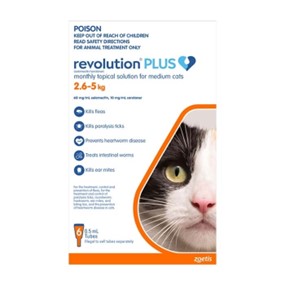
Sarah asks the customer if they know the weight of the cat. They reply that they think the cat is about 2 kgs.
Question: Based on this information, is this product suitable for the individual animal? Select the following heading, "Answer", to check if you were correct.
No. A 2 kg cat is too light for this weight bracket specified by the product information on the label.
Knowledge check 4

Types of animal care service information
Recall that an animal care service is work done with or for an animal by someone who is not the owner. When finding out information about an animal care service, the types of details clients or your team members are likely to require include:
- purpose, including intended species and life stage
- why it is required
- what is included in the service
- recommended price
- time required to provide
- availability
- associated safety precautions.
The specific information required will depend on the service and the needs of the client or team member.
Boarding and day care facilities
Boarding establishments care for dogs and cats when their owners are away from home. They offer either day boarding, overnight boarding or both(Agriculture Victoria 2020a)
Different boarding facilities offer different services. Information you may be required to source about boarding facilities includes but is not limited to:
- maximum and minimum length of stay (in hours or days)
- specified drop-off and pick-up times
- price per hour or day, any price deals (for example, 10 weeks of day care for the price of 9)
- whether food/treats are included in the price
- options for additional services, such as grooming or training.
Grooming services
All animals need and often enjoy some level of grooming. While grooming helps an animal look nice, regular grooming also has several health benefits, including:
- preventing fur from matting, which can be painful and cause various skin conditions
- preventing overgrown nails and claws, which cause pain, toe and foot pad infections and difficulty with walking
- removal of grass seeds, which can cause discomfort and infections
- early detection of skin conditions and external parasites, such as ticks, mites and fleas.
Some common questions regarding grooming services include, but are not limited to:
- How often does the animal need to be groomed?
- What specific grooming tasks are recommended or required for the individual?
- Is professional grooming needed, or can the owner do it?
Training services
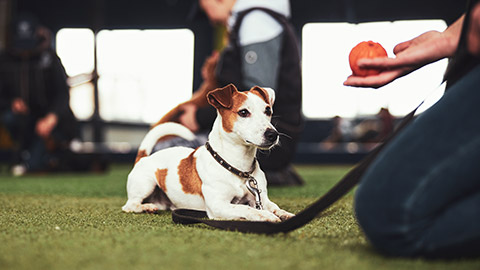
The government regulates some types of animal training. For example, in Victoria, under the Domestic Animals Act 1994, it is illegal to attack-train a dog unless the owner is a registered and licenced security guard.
General obedience and behavioural training, however, is readily available for cats and dogs (and other animals). Some common information requirements regarding animal training services include, but are not limited to:
- the level of experience and/or qualification the trainer holds
- the level of involvement of the owner in the process
- the behaviours that are targeted by the training
- recommended frequency and number of sessions
- length of each session
- times, availability and location of sessions
- price per session, any price deals (for example, 10 sessions for the price of 9)
- any required equipment.
Veterinary and allied health services
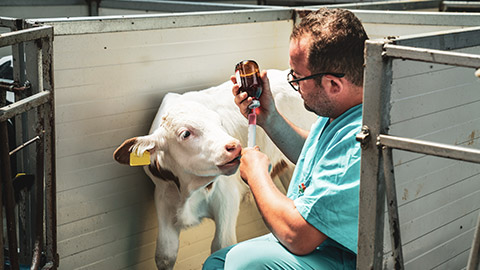
All animals require health care at some stage in their lives. Preventative and maintenance health care helps the animal avoid health issues and should be regularly administered. Allied health services, such as hydrotherapy and physiotherapy, can help treat long-term health issues and improve the animal’s quality of life.
Common questions relating to animal health care services include, but are not limited to:
- How often does the animal require a health check?
- What specific treatment/medication does the animal need?
- What preventative treatments can the owner do at home?
- What changes to the normal routine are needed during a period of recovery?
Outsourced services
Outsourced services are required in addition to the primary service. They are only needed when the primary service cannot provide every aspect. To determine whether an outsourced service is required, you will need to confirm what is included in the original service.
Outsourced services may include services such as:
- additional animal care services
- product delivery or transport
- product installation
- removal of old or broken items
- waste removal.
Is this the right service for you?
Before you provide animal care service information to a client or team member, review the information you have sourced. Is the information relevant, and does it meet the animal care service needs the person is requesting?
After you have provided the service information, ask the client or your team member if the information answers their request. Some of the information may need clarification or the client may require additional information. They may also ask you to confirm the information with the service provider.
Study the following scenario where an animal care attendant reviews information to determine a client’s relevance to needs and makes enquiries to clarify and confirm the service.
Scenario: Pet Boarding
Peta works as an animal care attendant at Willowtree Veterinary Clinic. A regular client, Joanne, walks in and requests information about a local boarding facility for her pets because she is going overseas for three months.
Peta passes the business cards of two local boarding facilities to Joanne and tells her that many clients have successfully used these services. Peta then asks Joanne if this is all she is after for today. Joanne scans the cards and asks Peta if she knows if any of them cater for snakes.
Joanne says she has recently adopted a Centralian Carpet Python. She is looking for a facility with a confident, experienced snake keeper because her snake is still young and can be a bit snappy.

Peta isn’t sure if any of the pet boarding facilities cater for pet snakes, so she quickly looks them up online. Success! Tip Top Pet Boarding lists minding reptiles (with their tank) as one of their additional services.
Joanne is happy with this but is still unsure and would like some more information about the service, such as their snake-handling experience and whether they can house both her snake and her dog while she is away.
Peta offers to call Tip Top Pet Boarding to clarify whether they are qualified and to confirm availability for both pets. Thankfully the manager of Tip Top Pet Boarding has several pythons at different life stages of his own and is more than happy to mind Joanne’s Centralian Carpet Python as well as her dog. The dates she is after are currently available. Joanne asks for the Tip Top Pet Boarding manager to pencil her pets in for those dates and says she will call them when she gets home to confirm the booking.
Joanne thanks Peta for helping with that information and walks out.
To recap, to clarify, confirm or source additional service information, you can:
- contact the service provider directly
- speak to your supervisor or other experienced and knowledgeable team members
- do further research.
Knowledge check 5
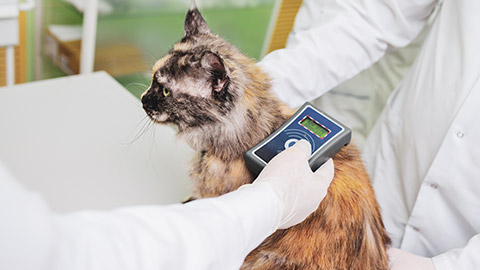
Most animal care organisations will keep some form of record of the animals they work with. These records store information about the individual animals and the services and products they may have received. New and relevant information should be added to an animal’s records each time a service or product is provided.
When a team member or client asks you for information, it is important to document what information you provided, but also the source of that information for future reference, should you or others need it.
A client may ask, "Why did we decide that this cat food is best for my senior cat?" You would then refer to the animal record and find that because you documented the information you provided to the client, along with its source, you can quickly verify why that decision was made.
To use and add information to individual animal records:
- Identify the individual animal
- Locate and access the workplace records or information management system
- Identify the specific individual animal record
- Cross-check the record with the animal and its (or the owner’s) needs
- Use the record to provide information to others or update the record as required.
Identify the individual animal
To ensure the best possible care for an individual animal, it is important to identify the animal correctly before:
- providing any care needs
- providing information about the animal to another person
- updating any records about the animal.
Methods of identifying animals include using the animal’s:
- basic anatomical features of species and/or breed
- microchip number
- tags, bands, brands, tattoos or other distinguishing features.
You will likely need to use a combination of methods to identify the animal confidently.
Basic anatomical features
Basic anatomical features are physical characteristics that are common to all normal and healthy members of a particular group. The more specific the group, the more refined the features are.
While working in the animal care industry, through experience, you will learn to identify species and breeds of animals that you come into contact with regularly.
Species defining characteristics
Most people are confident about telling the difference between the common species of domestic animals. For example, most people can tell the difference between a cat and dog, or between a horse and cow with just a quick glance, without really knowing why. However, some key anatomical differences between similar mammal species include:
- cats have retractable claws, while dogs don’t
- mice (30-45 g) are considerably smaller than rats (230-450 g)
- horse and donkey hooves are a single structure, while cows, sheep and goats have cloven hooves (two parts to the hoof)
- horses grow long hair on their mane and tail, while donkey hair is naturally much shorter
- sheep have a philtrum (split upper lip) and grow wool instead of hair; goats have a single upper lip and grow hair.
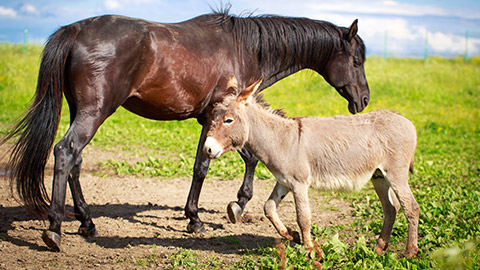
All species of animal have at least one anatomical feature that sets them apart from all other species. These features are often called defining characteristics. For example:
- bird species are usually identified by their size, beak shape and the colour and patterns of their feathers
- frog species are sometimes identified by their size, back, belly and inner thigh colours and patterns
- snake species are usually identified by the number of scales around their mid-section, the shape of scales on its head, and the shape and type of teeth (Department of Environment and Science 2022).
Breed defining characteristics
Selective breeding of domestic animals over many generations has created various forms of the same animal. These forms are called breeds. Different breeds have features that distinguish them from the other breeds of the same species.
For example, Australian Cattle Dogs are 43-50 cm tall with short, smooth, double-layered coats (American Kennel Club n.d.a). In comparison, Scottish Terriers are only around 25 cm tall with medium-length, wiry, double-layered coats (American Kennel Club n.d.b).
Australian Cattle Dog
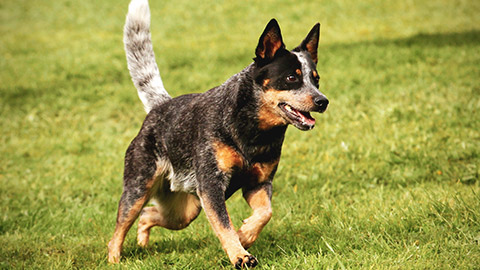
Scottish Terrier
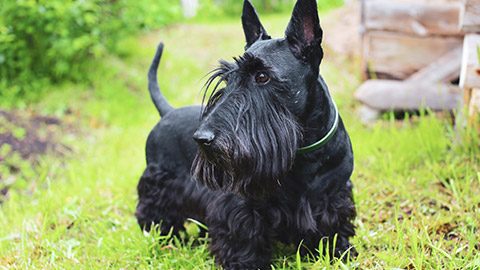
As your experience working with animals grows, so too will your skill in identifying different breeds of animals. Until then, if you are not confident, confirm with your supervisor or other experienced staff members that you have correctly identified the breed.
Microchipping
Microchipping an animal means inserting a tiny microchip (about the size of a grain of rice) under the skin of an animal, usually at the back of the neck, between the shoulder blades. Each microchip has its own unique number, which is recorded in a database and linked with details about the animal and the owner’s contact details (RSPCA n.d.).
Scanning the microchip will automatically retrieve the relevant information from the database and is an excellent method of identifying an individual animal. Scanning a microchip can confirm the animal’s identity before providing a specific treatment or service as well as identifying lost animals and the information needed to contact the owner.
The RSPCA recommends that all companion animals are microchipped. Currently, compulsory microchipping legislation is in place for cats and dogs in the ACT, NSW, QLD, VIC and WA. The legislation only covers microchipping dogs in Tasmania (RSPCA n.d.).
Visual identification
Other methods of identifying an individual animal include other visual points of identification. For example, details about specific markings or tattoos could be recorded on the animal’s file.
Leg bands

While many birds are large enough to carry a microchip, leg bands are a common method of identifying individuals, especially in wild populations. A leg band is a small ring with a number printed on it, which wraps around the bird’s ankle.
Ear tags
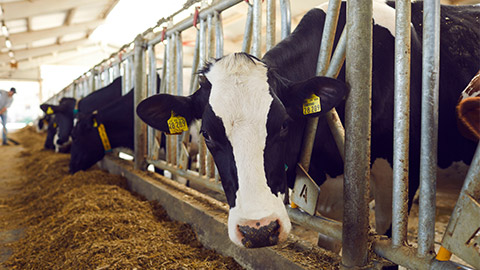
Ear tags are still the most common way to identify individual livestock animals, such as cattle, sheep and goats. The coloured and numbered tags are inserted into one or both ears of the animal and help identify the owner as well as the individual animal.
Brands

Brands are marks made on the skin of an animal using either a hot or a cold brand (a piece of metal in a specific shape used to represent the owner of the animal).
Hot branding uses a heat brand, which burns the hair and leaves a permanent scar on the skin. Freeze branding uses a brand cooled with dry ice or liquid nitrogen, which damages the pigment cells and causes the hair to grow back white.
Locate and cross-check the specific individual animal record
The type of individual animal records and the information they contain will depend on your workplace. You will first need to establish where the records are kept and whether the animal you are working with has an existing record.
Make sure you have access to the records, whether they are physical copies or if you need login details to access digital records and databases.
Animal identification databases
There are several animal identification databases, often specific to an industry or classification of animal. For example, companion animal microchipping databases and the National Livestock Identification System (NLIS).
Microchip databases
All microchip manufacturers provide a database for the companion animals that use their microchips. There are several microchip databases used in Australia. Scanning the animal’s microchip will typically tell you which database the information is in if the details are not immediately accessible by simply scanning the microchip.
National Livestock Identification System
The NLIS is an Australian database that identifies cattle, sheep and goats. It uses a combination of visible and electronic ear tags to identify individual animals. The physical location of each animal is recorded using specific Property Identification Codes. The database houses all individual animal information, including vaccinations and preventative health treatments, ownership, physical location and sales histories (Integrity Systems n.d.).
Workplace records
Cage cards
Cage cards are very basic records. They typically contain the following animal information:
- name
- microchip number
- owner details
- species and breed
- age
- colour
- sex
- whether the animal is entire or desexed
- weight
- check-in date.
Depending on the animal care facility, the cage card may also contain the:
- feeding plan
- services required
- vaccination history
- preventative health treatment due dates
- medication and supplement requirements
- behavioural and general health observations.
The following is an example of a cage card for Watermelon, the Guinea pig.

| ABC All Animal Boarding | ||||||
|---|---|---|---|---|---|---|
|
Animal name:Watermelon Microchip: 1234567891011120 |
Owner name: Truss Owner number: 0400 800 800 |
Species: Cavy (guinea pig) Breed: Satin Age: 1 year Colour: Golden |
Sex: Female Desexed: No Weight: 470 g |
|||
| Stay | Feeding | Services | ||||
|
Date in: 18/12/2022 Date out: 01/02/2023 |
Product: Fresh vegetables (named container in the fridge) Amount: 1/2 cup per meal Frequency/timing: Morning and evening |
Hydrobath - flea/tick: Hydrobath - medicated: Hand bath: |
Clip (details): Nail clip: Yes |
|||
| Vaccinations | Preventative health | Medication / supplements | ||||
|
Due date: n/a Type: |
Product:n/a Due date: |
Product: Vitamin C powder Dose: 1/2 scoop daily Timing: Evening, on food |
||||
| Notes: | ||||||
| Date | Eat | Drink | Urine | Faeces | Medication | Notes: |
| 18/12/2022 am | ✔ all | ✔ | ✔ | ✔ | ||
| 18/12/2022 pm | ✔ half | ✔ | ✔ | ✔ | Vitamin C powder | |
| 19/12/2022 am | ✘ none | ✔ | ✔ | ✔ Runny | Lethargic | |
Medical histories
In addition to the basic information kept on a cage card, veterinary clinics keep detailed medical patient histories, including information about preventative and health maintenance treatments, any first aid incidents or other medical treatments. It is critical to keep these records up-to-date and accurate to ensure the best care for the animal. Good file notes will be detailed while being clear, concise and use accurate industry terminology.
Other records
For other services, the records may be very brief. For example, a groomer may simply keep the animal and owner details and the date and type of last service.
Cross-check the record with the animal
Once you have identified the animal and the record, cross-check:
- your identification of the animal with the record details
- any database information against existing workplace records
- the owner’s contact details.
Make sure all the information is accurate and consistent. If there are inconsistencies, check with your supervisor to identify the correct information. You may need to update the record.
Provide individual animal information to others
When providing individual animal information to a team member or client, make sure you provide information that is accurate and consistent with the animal record. Only provide the information that is required and that you are qualified to provide. For example, at this level of qualification, you are not to provide diagnosis or treatment information, even if it is in the animal’s record. That type of information is for the qualified vet to provide.
Only share information that may be considered private, such as owner contact information and microchip number, when absolutely necessary for your workplace requirements. For example, you must not provide client information to another client. However, you may share an animal record and its associated client information with another animal care facility with the client’s consent.
Update the record

All records should be kept up to dateup-to-date and accurate. As with documenting the sources of information, it is best to do this as soon as possible, before you forget the details.
Ensure the information you add to the record is easily understood - use plain English and appropriate industry terminology to document new information. For example, ‘canine’ rather than ‘dog’.
Firstly, the record should identify the animal and owner details clearly. When you enter information about an animal, gather all the relevant details. This will help your workplace determine what the animal in your care requires and helps ensure the best possible care. Consistently update the record each time the animal comes to your organisation.
Some examples of types of information that may need to be updated include, but are not limited to:
- any medication and the frequency of required doses
- preventative health products, including date of last treatment
- type and date grooming
- any communication with the owner, especially if they asked for or if you provided them with information.
If relevant, you may need to set up an alert for the owner to remind them when the next service or treatment is required.
Review the following scenario to gain some insight into what information is typically entered on an animal identification record, including cross-checking and one type of update that you may need to make while working in the animal care industry.
Scenario: Doug the Pug

A client arrived at Long Road Veterinary Clinic with his pet Pug on 23 November 2022.
Jessie, an animal attendant, who has just started working at the clinic this week, greets the client and then confirms the Pug’s details.
She says, “Hi, how are you? Who do we have here today?”
The client confirms that he has ‘Doug’ with him and is here for his dog’s weekly weigh-in.
Jessie replies, “Can I get your surname, please?”.
The client replies that his surname is ‘Smith’.
Jessie now knows that she should look up ‘Doug Smith’ (the patient) and retrieves his file on the clinic’s computer database.
She then asks the client (John Smith) to confirm his contact details, email address and phone number. The details all match, so Jessie does not need to update them.
Jessie then opens Doug’s medical record, which is one of the tabs on the client’s file. She scans his microchip and cross-checks that the number on the record matches. It does.
Next, she asks John to pop Doug onto the scales while the vet reads the measurement. Jessie immediately records the new weight from today on the patient file (shown in red). The reading is 11.3 kg.
Jessie confirms with John that, according to last week’s weight reading of 11.5 kg, Doug has lost weight. The vet asks him to visit for Doug’s next weighing in one week. An SMS reminder message has been set up to remind John the day before his next visit.
The following animal identification details and health records are examples of the information that is likely to be found on Doug’s patient file after the visit on November 23rd.
Doug’s individual Record
| Animal identification | Details |
|---|---|
| Name | Doug |
| Age | 11 years |
| Date of birth | 10.10.2011 |
| Breed | Pug |
| Sex | Male |
| Entire/Desexed | Desexed |
| Colour | Tan and black |
| Microchip number | 9704635400091827 |
| Owner | Details |
|---|---|
| Name | John Smith |
| Phone | 0404 123 456 |
| john.smith@mail.com | |
| Address | 123 Long Road |
| Name of veterinarian | Long Road Vets |
| Medical history | Details |
|---|---|
| Allergies | None |
| Existing conditions | Osteoarthritis hind limbs - diagnosed 2020 |
| Notes |
Overweight 16 Nov: Doug has been put on Hill’s Metabolic dog food to reduce weight. Weekly weighing is recommended until Doug reaches the goal weight of 9.5 kg. Weekly weight information:
|
Knowledge check 6
